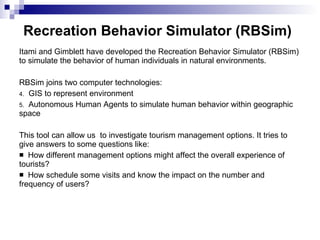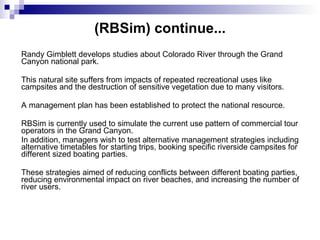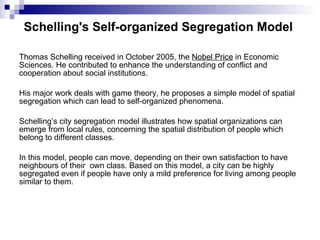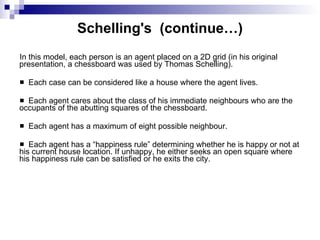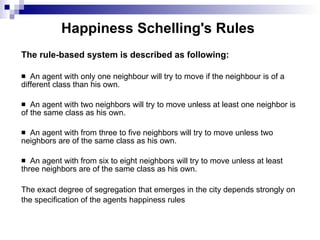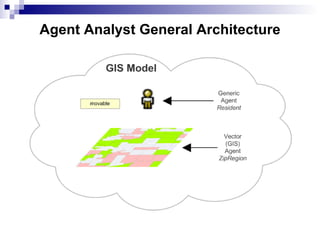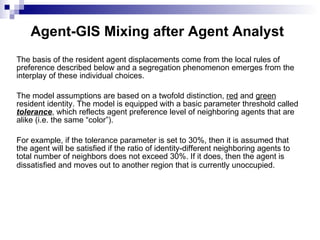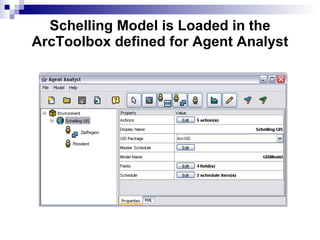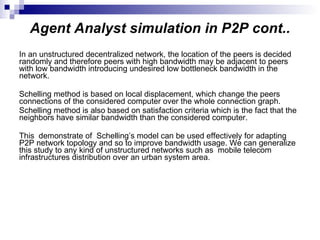Self Organization Simulation Over Gis Based On Multi Agent Platform
- 1. Self-organization Simulation over Geographical Information System (GIS) based on Multi-Agent Platform Presented by Anas Amjad Obeidat
- 2. Outlines Introduction Geographic Information System GIS Applications GIS Conceptual Model Layers Individual-based Model (IBM) Mixing IBM AND GIS The Chsaracteristics and Advantages of IBM Recreation Behavior Simulator (RBSim) SCHELLING'S SELF-ORGANIZED SEGREGATION MODEL Happiness Schelling's Rules Mixing Agent-based Simulation and GIS Model Support to Implement Self-organized Segregation Model Agent Analyst General Architecture Agent-GIS Mixing after Agent Analyst Agent Analyst simulation in P2P Conclusion and Perspectives References
- 3. Introduction The challenge of the simulation of complex systems modelling based on Geographical Information System (GIS) is to propose: Future decision making supports for urban planning's or environmental. Social-politic development Geographers manage today a great amount of geographical data and need innovative methodologies to analyse them in a applicable way. A complex vision of the current world is strongly needed in order to face nowadays challenges in understanding, modelling and simulating The increasing of intensive communications, allowed by high technologies, leads to develop in efficient way .
- 4. Geographic Information System A geographic information system (GIS), or geographical information system, captures, stores, analyzes, manages, and presents data that is linked to location. In the strictest sense, the term describes any information system that integrates, stores, edits, analyzes, shares, and displays geographic information. In a more generic sense, GIS applications are tools that allow users to create interactive queries (user created searches), analyze spatial information, edit data, maps, and present the results of all these operations. Geographic Information Science is the science underlying the geographic concepts, applications and systems, taught in degree and GIS Certificate programs at many universities.
- 5. GIS Applications GIS technology can be used for Scientific investigations Resource management Asset management Archaeology Environmental impact assessment Urban planning Cartography Criminology Geographic history Marketing Logistics Prospectively Mapping, and other purposes. For example, GIS might allow emergency planners to easily calculate emergency response times in the event of a natural disaster, GIS might be used to find wetlands that need protection from pollution, or GIS can be used by a company to site a new business location to take advantage of a previously under-served market.
- 6. GIS Conceptual Model Layers The actual GIS conceptual model is based on a layered structure (Goodchild et al., 1991). A layer allows gathering, in a same set, some objects corresponding to a specific thematic . Hydrological layer Building layer Road layer ... Some new challenges for GIS future development, is to use the new conceptual models given by complexity theories to automatically identify some dynamical organizations and so to manage scenario of developments which can be used to determine automatically some social or urban re-organizations .
- 7. Individual-based Model (IBM) IBM offers potential for studying complex system behaviours and human/landscape interactions within a spatial framework. Artificial intelligent agents introduce behaviour conditions and set communications or interactions between them and their environment as the major rule of the simulation evolution. Agents have goals who lead their interactions or actions over the world. Few researchers have mixed spatially explicit agents and GIS. After a non exhaustive review on that subject, we will focus our attention on Agent Analyst, based on Repast Multi-agent system. Agent Analyst can be presented as a free extension to ESRI's products like ArcGIS .
- 8. Mixing IBM AND GIS The use of Individual-Based Model (IBM) is a promising approach to model spatially explicit ecological phenomena. The successive efficient computer science concepts used for that purpose : Cellular automata theory which has demonstrated efficiency about modeling landscape dynamics by regular rules-based processes. Object-oriented modeling (OOM) which has proved its power by representing the domain with concrete objects that have as much similarity with their real world counterparts as possible . The spatially explicit model mixed with object-based modeling lead to define the individual-based modeling (IBM). Artificial intelligent agents (Wooldridge, 2002) introduce behavioral conditions and set communications or interactions between them and their environment as the major rule of the simulation evolution. Agents have goals who lead their interactions or actions over their world.
- 9. The Characteristics and Advantages of IBM A variety of types of differences among individuals in the population can be accommodated. Complex system decision making by an individual can be simulated. Local interactions in space and the effects of stochastic temporal and spatial variability are easily handled. The first goal is to have a virtual laboratory to study the outcomes of various behavior on realistic landscapes.
- 10. Recreation Behavior Simulator (RBSim) Itami and Gimblett have developed the Recreation Behavior Simulator (RBSim) to simulate the behavior of human individuals in natural environments . RBSim joins two computer technologies: GIS to represent environment Autonomous Human Agents to simulate human behavior within geographic space This tool can allow us to investigate tourism management options. It tries to give answers to some questions like: How different management options might affect the overall experience of tourists? How schedule some visits and know the impact on the number and frequency of users?
- 11. (RBSim) continue.. . Randy Gimblett develops studies about Colorado River through the Grand Canyon national park. This natural site suffers from impacts of repeated recreational uses like campsites and the destruction of sensitive vegetation due to many visitors. A management plan has been established to protect the national resource. RBSim is currently used to simulate the current use pattern of commercial tour operators in the Grand Canyon. In addition, managers wish to test alternative management strategies including alternative timetables for starting trips, booking specific riverside campsites for different sized boating parties. These strategies aimed of reducing conflicts between different boating parties, reducing environmental impact on river beaches, and increasing the number of river users.
- 12. Dynamical agents move across the landscape in RBSim (after Gimblett)
- 13. Schelling's Self-organized Segregation Model Thomas Schelling received in October 2005, the Nobel Price in Economic Sciences. He contributed to enhance the understanding of conflict and cooperation about social institutions. His major work deals with game theory, he proposes a simple model of spatial segregation which can lead to self-organized phenomena. Schelling’s city segregation model illustrates how spatial organizations can emerge from local rules, concerning the spatial distribution of people which belong to different classes. In this model, people can move, depending on their own satisfaction to have neighbours of their own class. Based on this model, a city can be highly segregated even if people have only a mild preference for living among people similar to them.
- 14. Schelling's (continue…) In this model, each person is an agent placed on a 2D grid (in his original presentation, a chessboard was used by Thomas Schelling). Each case can be considered like a house where the agent lives. Each agent cares about the class of his immediate neighbours who are the occupants of the abutting squares of the chessboard. Each agent has a maximum of eight possible neighbour. Each agent has a “happiness rule” determining whether he is happy or not at his current house location. If unhappy, he either seeks an open square where his happiness rule can be satisfied or he exits the city.
- 15. Happiness Schelling's Rules The rule-based system is described as following: An agent with only one neighbour will try to move if the neighbour is of a different class than his own. An agent with two neighbors will try to move unless at least one neighbor is of the same class as his own. An agent with from three to five neighbors will try to move unless two neighbors are of the same class as his own. An agent with from six to eight neighbors will try to move unless at least three neighbors are of the same class as his own. The exact degree of segregation that emerges in the city depends strongly on the specification of the agents happiness rules
- 16. Results of Schelling's Model Computed on a Cellular Automaton
- 17. Schelling's Segregation Model Implemented by N. Gessler
- 18. Mixing Agent-based Simulation and GIS Model Support to Implement Self-organized Segregation Model Agent Analyst is an Agent-Based Modelling and Simulation (ABMS) extension for the ESRI's ArcGIS suite of products (Agent Analyst, 2006). Agent Analysis Characteristic: Agent Analyst integrates and extends the functionalities of the open-source Repast modelling and simulation. The Recursive Porous Agent Simulation Toolkit (Repast) is an agent modelling toolkit (Repast, 2006). It borrows many concepts from the Swarm agent-based modelling toolkit, but it multiple pure implementations in several languages and built-in adaptive features such as genetic algorithms and regression. Repast seeks to support the development of extremely flexible models of living social agents, but is not limited to modelling such entities. Agent Analyst fully integrates ABMS with GIS. Through this integration, GIS experts gain the ability to model behaviours and processes as change and movement over time while ABMS modellers are able to incorporate detailed real-world environmental data, perform complex spatial processes, and study how behaviour is constrained by space and geography. Furthermore, ABMS models can include real-time GIS data for situations such as disaster management, fire fighting, or resource management.
- 19. Agent Analyst continue … The graphical Agent Analyst tools allow the user to create agents, schedule simulations, establish mappings to ArcGIS layers, and specify the behaviour and interactions of the agents. In the following, we will show how using Agent Analyst for Schelling's problem. A sample will be given using GIS and agent model and develop the use to implement it. In the following, the Schelling segregation model is applied on a GIS vector layer rather than a 2D grid (Lingman-Zielinska, 2005). The implementation is made using Agent Analyst over ArcGIS. The model is composed of two main parts. The first one is an environment layer of zip code regions from a GIS and represented in Agent Analyst by a non movable vector GIS agent. The other part is a set of movable generic agents , which represent the city residents who make decisions of moving to a new location (zip region).
- 20. Agent Analyst General Architecture
- 21. Agent-GIS Mixing after Agent Analyst The basis of the resident agent displacements come from the local rules of preference described below and a segregation phenomenon emerges from the interplay of these individual choices. The model assumptions are based on a twofold distinction, red and green resident identity. The model is equipped with a basic parameter threshold called tolerance , which reflects agent preference level of neighboring agents that are alike (i.e. the same “color”). For example, if the tolerance parameter is set to 30%, then it is assumed that the agent will be satisfied if the ratio of identity-different neighboring agents to total number of neighbors does not exceed 30%. If it does, then the agent is dissatisfied and moves out to another region that is currently unoccupied.
- 22. Agent Analyst Load the City Layer Shape in ArcMap
- 23. Schelling Model is Loaded in the ArcToolbox defined for Agent Analyst
- 24. Agent Analyst Actions Editor Actions editor was designed to automate the process of programming model actions. It composes all the necessary elements that constitute an action . Since an action is a method in object-oriented programming language, which is here a variant of Python, need to define its name, import the necessary classes (modules) from outside the model (if we need any), use pre-existing variables, and finally write the code for action. Once all the elements are defined, we can compile and run the model. One possible issue of the schelling model in the initial map defined previously can be represented by following figure. In this figure we have the Repast toolbar which allows managing the simulation execution.
- 26. Agent Analyst simulation in P2P Even if segregation is an important problem to manage or to control the urban systems development, the schelling model can be used and generalized to many others problems, especially for non structured networks . A. Singh and M. Haahr have proposed an extension of Schelling model for managing peer to peer (P2P) networks. P2P is a new way of decentralized organization for communication over networks. Because of the increasing possibilities to share and to distribute efficient computers at low cost on many position on a network, the P2P way of communication could be one of the major in the future. The robustness of such networks in any kind of critical situations can make them powerful and efficient.
- 27. Agent Analyst simulation in P2P cont.. In an unstructured decentralized network, the location of the peers is decided randomly and therefore peers with high bandwidth may be adjacent to peers with low bandwidth introducing undesired low bottleneck bandwidth in the network. Schelling method is based on local displacement, which change the peers connections of the considered computer over the whole connection graph. Schelling method is also based on satisfaction criteria which is the fact that the neighbors have similar bandwidth than the considered computer. This demonstrate of Schelling’s model can be used effectively for adapting P2P network topology and so to improve bandwidth usage. We can generalize this study to any kind of unstructured networks such as mobile telecom infrastructures distribution over an urban system area.
- 28. Conclusion and Perspectives Implementation of the Schelling's segregation model over a Geographical Information System, using mixing with Agent Based Modelling and Simulation. Extension can be find to P2P network management but also more generally, to interaction network management. The mixed GIS-ABMS platform is intended now to be connected to ant systems (Bertelle et al., 2006) and automata models to allow to represent evaluative negotiation processes (Ghnemat et al., 2006). Applications to economy and urban development are well-suited to this fore coming studies.
- 29. References Agent Analyst web site (2006) http://www.institute.redlands.edu/agentanalyst/ Aziz-Alaoui M.A. and Bertelle C. (2006) “Emergent Properties in Natural and Artificial Dynamical Systems”, Understanding Complex Systems, Springer. Bertelle, C., Dutot, A., Guinand, F. and Olivier, D. (2006) "Organization Detection using Emergent Computing". Int. Transactions on Systems Science and Applications , Special Issue "Self-Organizing, Self-Managing Computing and Communications". Gessler, N. (2006) “”Building Complex Artificial Worlds” web site. Ghnemat, R., Oqeili, S., Bertelle, C. and Duchamp, G.H.E. (2006) “Automata-Based Adaptive Behavior for Economic Modeling Using Game Theory” in M.A. Aziz-Alaoui and C. Bertelle (eds) “Emergent Properties in Natural and Artificial Dynamic Systems”, Understanding Complex Systems, Springer. Gimblett, H.R ed. (2002) “”Integrating Geographic Information Systems and Agent-based Modeling Techniques”, Santa Fe Institute studies in the sciences of complexity, Oxford University Press. Goodchild, M.F., Rhind, D. and Maguire, D.J. (1991) “Geographical Information Systems: Principles and Applications”, Longman, New York Ligman-Zielinska, A. (2005) “Agent Analyst tutorial – Schelling GIS”, San Diego University. Repast web site (2006) http://repast.sourceforge.net/ Singh, A. and Haar, M. (2004) “Topology adaptation in P2P Networks using Schelling's model”, Workshop on Emergent Behavior and Distributed Computing, PPSN-VIII Wooldridge, M. (2002) “An introduction to Multi-Agent Systems”, John Wiley & Sons.









